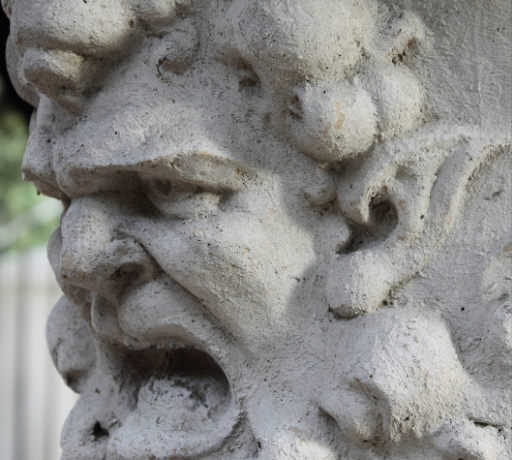Dear Readers,
The Texas Department of Criminal Justice has introduced a new rule in its Offender Orientation Handbook stating that “offenders are prohibited from maintaining active social media accounts for the purposes of soliciting, updating, or engaging others, through a third party or otherwise.”
Pending legal clarification of the new Texas Department of Criminal Justice offender rule #4, regarding the use of social media in support of prisoners, writing and artwork from Texas prisoners will not be accessible on Minutes Before Six. Thank you for sharing with your networks and for your understanding.
Sincerely,
The Minutes Before Six Team
By Burl N. Corbett
In the mid-eighties, tired of working for others, I started my own masonry business. One evening I received a phone call from a woman in the Reading, Pennsylvania suburb of Shillington—John Updike’s fictional hometown of “Olinger”—who wanted an estimate to repair her front yard retaining wall. We arranged an appointment, and when I arrived a few days later I realized that she lived across the street from Updike’s childhood home. In fact, the dogwood tree planted by his grandfather in 1932 to commemorate his birth still thrived in the side yard. After introducing myself to the lady, a pleasant-mannered widow who operated a notary public business from her home, I measured up the wall, calculated the cost of materials, estimated my labor, and tacked on my anticipated profit. She agreed to the price, and within a week I began the job.
On the first day of work, the lady—whom I’ll call “Mary”—came outside every few hours to check on my progress and talk. Oh, but how she loved to talk! During one of these chats, I asked if she knew that the white brick house on the opposite side of Philadelphia Avenue-—State Route 724—had once been the boyhood home of the noted author John Updike.
“Yes, so I’ve been told,” she replied indifferently.
Undaunted by her apparent disinterest, I pointed to a barely visible low stone wall a few blocks down the street. “That section of wall down there—can you see it?—is all that’s left of the old county poorhouse where Updike set his first novel, The Poorhouse Fair.“
Mary glanced doubtfully in the general direction of my finger, then looked back at her wall, the only one she cared about. “Is that so? I never got around to reading any of his books,” she confessed without a shred of regret. I was obviously boring her, so I dropped the subject and we resumed our safe, if dull, conversation about the weather and other inanities as the traffic whooshed and rumbled by.
The next day, while I ate a noontime sandwich in my truck and scanned the morning newspaper, Mary came down the concrete stairs of her terraced front yard and invited me in for an icy glass of sun tea. Sure, I said, dutifully following her to the front door, which she flung open with a little smile of pride. I glanced inside and froze. “Uh, Mary, I can’t come in dressed like this,” I pleaded, gesturing at my cruddy clothes and my scuffed boots. “I’m too dirty.” It was a lame excuse, but the best I could muster on short notice.
Pooh-poohing my misgivings, she assured me that it was okay. “Just don’t sit on the furniture, dear, and you’ll be fine,” she directed, closing the door behind us. As my eyes slowly adjusted to the subdued lighting, I was struck dumb by her atrocious taste: it was an Augean stable of vulgarity, badly in want of a stout Hercules with a large dumpster. Had a tsunami of utter tackiness once swept through her home, or had Liberace left on her doorstep a Trojan horse filled with gaudy knockoffs of his favorite furniture? Or had she purchased at some beastly yard sale a cornucopia chock-full of ankle-tickling shag rugs and over-stuffed, plastic-slipcovered easy chairs and oh-so-precious, never-to-be used love seats? Tinted mirrors set in gilded rococo frames? Got ’em! Betassled footstools worthy of the Grand Pooh-Bah of Las Vegas? Take your choice! Cutesy-wootsey knicknacks aligned just so atop a fake mantel of a phony fireplace stuffed with artificial logs? You betcha! A baker’s dozen and then some of framed old-timey adages and hoary homilies hung upon walls covered with hideously patterned flocked wallpaper? Damn straight! The only thing missing to complete the illusion of a fin de siècle French whorehouse was a trio of over-the-hill prostitutes sharing an opium pipe on a red velvet sofa. I was stunned. What could I possibly say?
Chattering nonstop, blind to my discomfort, Mary guided me through each of the downstairs rooms. Fortunately the “tour” didn’t include the upstairs, for if what I had already witnessed was a hint of the decorative horrors lurking in her boudoir, I doubt if my constitution could have withstood the shock. It was understandable why she had remained unmarried: the heterosexual man who would willingly live in such a frilly dollhouse stuffed with over-the-top froufrou was yet to be born. But she seemed content, a harmless eccentric, an amicable woman who had somehow managed to avoid the fate that often befell lonely widows and divorcées: she hadn’t yet been taken up by cats.
Standing in her kitchen, the tour concluded, I hastily drank my tea, complimented her on her home, and then expressing concern that the concrete I had poured might be setting up, managed to flee. If I had been a practicing Catholic, I might have hurried to the nearest church and sprinkled myself with holy water to protect my own bachelor fashion sense from similar corruption.
I finished the job without further incident and moved on to other jobs for other people who weren’t impelled to show me their homes. Occasionally when I happened to drive past Mary’s residence, I thought of the stylistic crimes concealed behind the innocuous facade of her house and shuddered. Eventually as the months and then the years passed, I forgot even those. Then, several years later, I read a short story of John Updike’s in The New Yorker entitled “The Other Side of the Street.” Its protagonist (obviously the author), searches the Yellow Pages for a notary public to transfer the title of his deceased mother’s car into his name. By chance, he happens upon Mary’s listing. Intrigued by her proximity to his old home, he calls her for an appointment. She urges him to come right over, and as soon as he steps through her door, she immediately gives him the “Tour.” Unlike me, the story’s hero is not only willing to play Dante to her Beatrice, but never mentions her deplorable deficiency of taste!
As the tale unfolds, it becomes evident that Mary’s character personifies the supposedly well-to-do people who lived in the row of hillside homes opposite that of the author’s less fortunate family. Now, however, the hero belatedly realizes that the folks whom the ten-year-old he once thought so lordly were in reality not much different than his own parents and grandparents. And in that narrative, Mary’s fashion faux pas are irrelevant to the plot, not to mention that the author was too decent a human being to make sport of another’s aesthetic shortcomings.
I put down the magazine and called Mary, eager to inform her that as the prototype of a character in Updike’s vast oeuvre she had achieved a tenuous immortality of sorts. She thanked me for thinking of her, but said that someone else (the author?) had already told her. If she was thrilled by her sudden, if anonymous, literary fame, she hid her excitement well. Could she have been a mite put out by Updike’s failure to praise her decorating talent? Personally, I thought she had gotten off rather easily; a less compassionate writer might not have been so kind. But then John’s good angel would never permit his bad angel to turn his pen against anyone as sweet as Mary. After all, apart from her dubious taste, she made a killer glass of sun tea!
If you find value in Minutes Before Six please make a donation. We need your support!





No Comments